
Episcia is a genus of flowering plants in the African violet family, Gesneriaceae. The ten species it contains are native to the tropical regions of Central and South America. The species are perennial herbaceous plants characterized by a stoloniferous habit, red flowers, and frequently have marked or patterned leaves. Episcias are sometimes called flame violets.

Columnea is a genus of around 200 species of epiphytic herbs and shrubs in the family Gesneriaceae, native to the tropics of the Americas and the Caribbean. The tubular or oddly shaped flowers are usually large and brightly colored – usually red, yellow, or orange – sometimes resembling a fish in shape. A common name is flying goldfish plants due to the unusual flower shape.
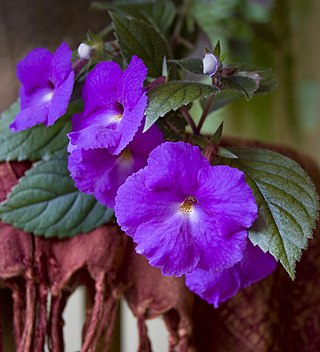
Achimenes is a genus of about 25 species of tropical and subtropical rhizomatous perennial herbs in the flowering plant family Gesneriaceae. They have a multitude of common names such as magic flowers, widow's tears, Cupid's bower, or hot water plant.

Kohleria is a New World genus of the flowering plant family Gesneriaceae. The plants are generally tropical herbs or subshrubs with velvety stems and foliage and brightly colored flowers with spots or markings in contrasting colors. They are rhizomatous and commonly include a period of dormancy in their growth cycle. The genus was revised in 1992 and was then recognized as having 19 species distributed in Central America and South America. phylogenetic in 2005 indicated that the epiphytic genus Capanea is derived from within Kohleria, and the two species of Capanea were subsequently transferred to Kohleria. The genus Pearcea is closely related.
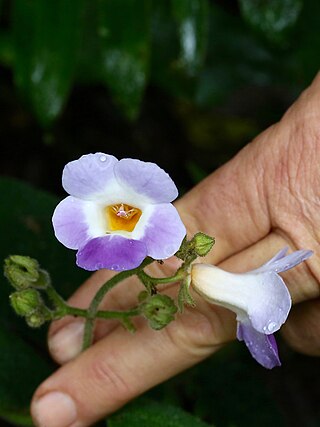
Monopyle is a genus of plants in the family Gesneriaceae.

Nautilocalyx is a genus of plants in the family Gesneriaceae. Its native range stretches from Costa Rica to southern Tropical America and to Trinidad. It is also found in Bolivia, Brazil, Colombia, Costa Rica, Ecuador, French Guiana, Guyana, Panamá, Peru, Suriname, Trinidad-Tobago and Venezuela.
Trichodrymonia aurea is a species of plant in the family Gesneriaceae. It is endemic to Ecuador. Its natural habitat is subtropical or tropical moist montane forests.
Trichodrymonia binata is a species of plant in the family Gesneriaceae. It is endemic to Ecuador. Its natural habitat is subtropical or tropical moist montane forests.

Trichodrymonia hypocyrta is a species of plant in the family Gesneriaceae. It is endemic to Ecuador. Its natural habitats are subtropical or tropical moist lowland forests and subtropical or tropical moist montane forests.
Trichodrymonia lacera, formerly Paradrymonia lacera, is a species of plant in the family Gesneriaceae. It is a terrestrial or epiphytic herb endemic to western Ecuador. Its natural habitat is tropical moist foothill and montane forest from 500 to 1,000 meters elevation. It is known from two collections in Cotopaxi Province. It may be extinct in the wild, but has been cultivated.
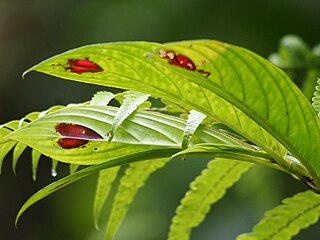
Columnea consanguinea is a species of flowering plants in the genus Columnea. They are endemic to Colombia, Costa Rica, Ecuador, Nicaragua, and Panama. They are distinctive for possessing red translucent heart-shaped markings on their leaves that serve to attract their main pollinators - the hummingbird Heliodoxa jacula - to their more inconspicuous flowers.

Trichodrymonia lineata is a species of plant in the family Gesneriaceae. It is an epiphyte native to Costa Rica, Panama, and northwestern Colombia.
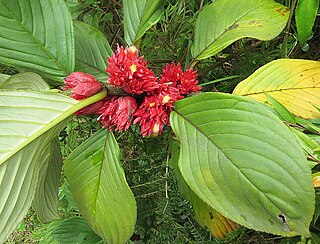
Glossoloma is a genus of Neotropical plants in the family Gesneriaceae. The species in the genus were formerly placed in Alloplectus. They are subshrubs with the leaves clustered at the ends of branches, and tubular flowers.
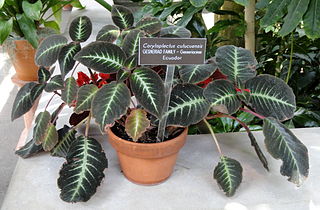
Corytoplectus is a genus in the plant family Gesneriaceae. Plants from Corytoplectus are found in Bolivia, Brazil North, Colombia, Ecuador, Guyana, Mexico Southwest, Peru, Venezuela, in the cloud-forests of the high cordillera. The genus contains c. 12 species. The genus differs from the closely related Alloplectus in having an erect umbellate inflorescence and berries. The type species is C. capitatus.
Trichodrymonia is a genus of flowering plants belonging to the family Gesneriaceae.
Amalophyllon is a genus of flowering plants belonging to the family Gesneriaceae.
Centrosolenia is a genus of flowering plants belonging to the family Gesneriaceae.
Cremosperma is a genus of flowering plants belonging to the family Gesneriaceae.
Cobananthus is a genus of flowering plants in the family Gesneriaceae, with a single species Cobananthus calochlamys. It is sometimes included in the genus Alloplectus, but molecular phylogenetic studies suggest that the two genera are not closely related, with Cobananthus more closely related to Alsobia.
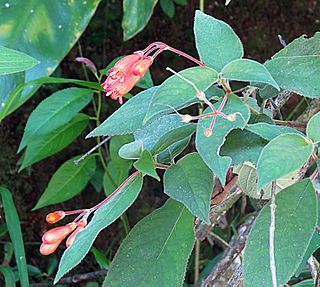
Moussonia is a genus of plants in the family Gesneriaceae. Its native range stretches from Mexico to Central America. It is found in Costa Rica, El Salvador, Guatemala, Honduras, Mexico and Panamá.












